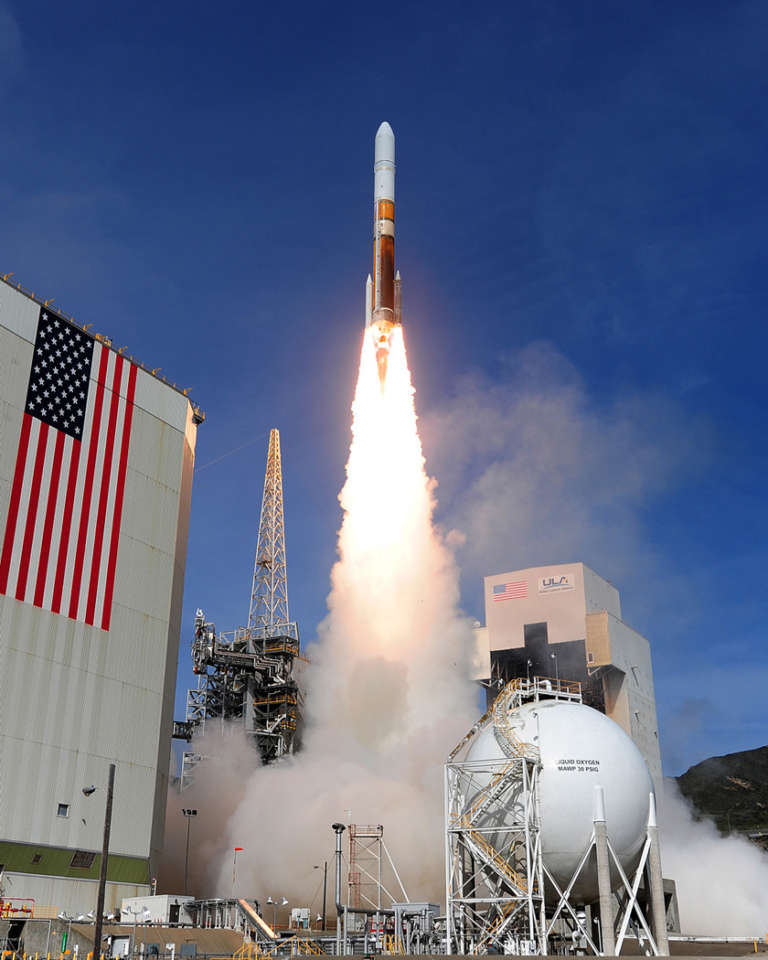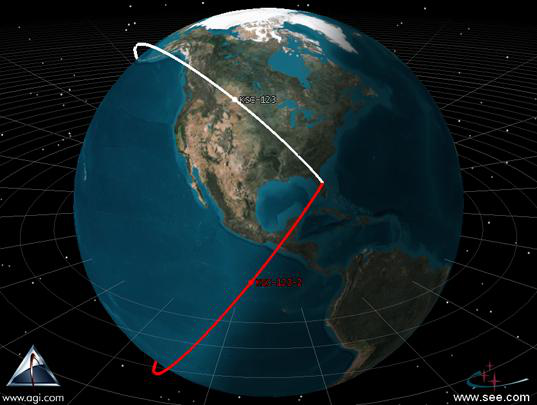Jason Davis • Apr 11, 2012
Of inclinations and azimuths
On Tuesday, April 3, a National Reconnaissance Office satellite roared into orbit atop a Delta IV rocket from Vandenberg Air Force base in California. Despite the classified nature of the the innocuously dubbed NROL-25 mission, one detail about the launch is publicly known: the satellite's unusual orbital inclination of 123 degrees. What makes this trajectory so unique? Pondering the answer affords the opportunity to learn some deceptively tricky concepts about the nature of all spacecraft orbits, not just the military ones.

Orbital inclination is the angle of the satellite's orbital plane with respect to the Earth's equatorial plane. Measure starting from due East on the equator, and trace an angle to the orbital plane on the side of the equator in which the satellite is travelling after it crosses. Inclinations always measure between 0 and 180 degrees. An orbit with an inclination between 0 and 90 degrees is considered prograde or direct (many astronomers prefer the latter term when it comes to natural satellites) and travels with the direction of the Earth's rotation. An orbit with an inclination between 90 and 180 is retrograde and travels against the Earth's rotation. A satellite with a 90 degree inclination is said to have a polarorbit, and does not have an east-west directional component.
As I read various articles about the odd inclination of NROL-25, one particular sentence in a story by Justin Ray for Spaceflight Now gave me pause. In order to reach an orbital inclination of 123 degrees, NROL-25 would have to take a distinct southwestern path out from the California coast:
"Typical Vandenberg launches head southward toward polar orbits or slightly southeastward on so-called "coast-hugger" ascents, depending on the payload's desired orbit."
I was puzzled because I was present at Vandenberg on October 28, 2011 for the launch of NASA's Suomi NPP satellite, which also launched in a southwestern direction to reach its eventual 97 degree orbital inclination. So was NPP also an atypical launch?
What I needed was an expert to help me clear this up. Enter Mike Loucks of Space Exploration Engineering, a consulting firm that specializes in, among other things, designing orbital trajectories. Mike has worked on the trajectory design for operational spacecraft like the International Boundary Explorer (IBEX), as well as upcoming missions like the Lunar Atmosphere and Dust Environment Explorer (LADEE). His Twitter profile aptly dubs his work as 'Trajectories 'R' Us.'
"97-98 degree orbits are fairly typical for "polar" orbits, and although they are technically "retrograde," nobody talks about them that way," Mike explains. So, while NPP's 97.1 degree orbit has a westerly component, that's still close enough to 90 to put it in the polar category, whereas NROL-25 is much more retrograde, and therefore atypical, with its 123 degree inclination.
Mike created a nice diagram using the Satellite Toolkit modeling software from Analytical Graphics, Inc.to show a range of orbits originating from Vandenberg. The dot on each path represents the point where the satellite enters orbit after a launch -- called orbital insertion -- assuming a circular, 300 kilometer orbit.

The white orbit represents NROL-25, on its retrograde, 123 degree orbit. The green orbit shows NPP on its technically retrograde, polar orbit of 97 degrees. Red represents a true polar orbit of 90 degrees.
What's with that 34 degree orbit, crossing the United States?
"Blue is a due East launch out of VAFB. That would give us an inclination of 34 degrees, the latitude of VAFB," says Mike. He is quick to remind me that this orbital trajectory would, in reality, not be allowed because it requires flying over land prior to orbital insertion.
But wait, how can a due East launch give us an inclination of 34 degrees? Wouldn't that result in an orbital inclination of 0 degrees? Nope, Mike says:
"The plane of the orbit always has to run through the center of the Earth." An easterly launch will begin drifting south until it passes through the equatorial plane, continuing until it reaches the matching latitude of the launch site below the equator, whereupon it will start heading northward again.
This brings up another important trajectory factor called launch azimuth. Launch azimuth is the initial launch direction, measured clockwise from zero degrees north. Our theoretical, due East launch from Vandenberg has a launch azimuth of 90 degrees, but results in an orbital inclination of 34 degrees, the latitude of Vandenberg Air Force Base.
Although we can't launch due East from Vandenberg, we could certainly do it from Cape Canaveral, Florida. So, what would be the orbital inclination of a rocket originating from Cape Canaveral with a launch azimuth of 90 degrees (due East)? You guessed it: the orbital inclination will equal the latitude of the launch site, 28.5 degrees. And, unlike our theoretical Vandenberg launch, this trajectory is legitimate; the allowable launch azimuths from Cape Canaveral range from 35 to 120 degrees (remember, launch azimuths are measured from due North).
Would it have been possible for NROL-25 to reach its orbital inclination of 123 degrees by launching from Cape Canaveral? Technically, yes, and Mike has the diagram to show it:

However, both trajectories are out-of-bounds for a Cape Canaveral launch because they require travelling over populated areas. No one on the East coast wants a spent solid rocket booster to come tumbling through their rooftop. Therefore, the Air Force had to choose Vandenberg, just as NASA does for its polar-orbiting satellite launches. In fact, Space Launch Complex 6 at Vandenberg was originally slated to be the second launch facility for the space shuttle, so it could reach polar orbits that were not allowed from Cape Canaveral.
So to bring our story full circle, NROL-25 is unusual because it has a 123-degree orbital inclination, which resulted in a southwestern launch azimuth from Vandenberg Air Force Base. NPP and other climate satellites like those in NASA's A-Train also utilize southwestern, retrograde trajectories, but their 97-98 degree orbital inclinations are close enough to 90 degrees for them to be considered polar.
Sadly, the reasoning behind this strange orbit remains hush-hush, as the NROL-25 mission is classified. However, for some speculation and background information on the mission, you can head over to NASASpaceflight.com.
Support our core enterprises
Your support powers our mission to explore worlds, find life, and defend Earth. You make all the difference when you make a gift. Give today!
Donate

 Explore Worlds
Explore Worlds Find Life
Find Life Defend Earth
Defend Earth

